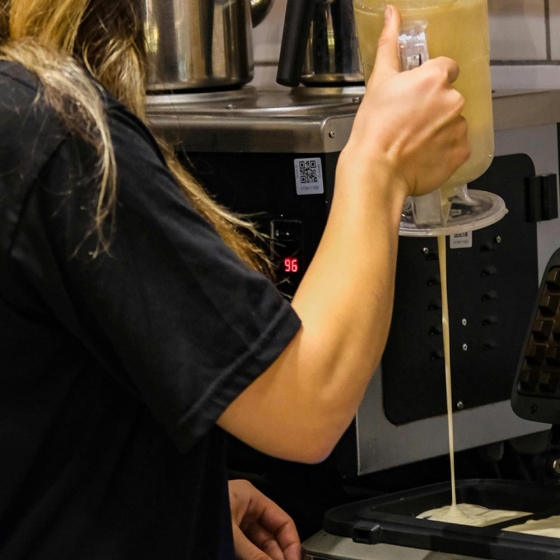Purchasing a commercial waffle maker is a significant investment for any food business. Whether you run a café, bakery, or food truck, the right equipment can boost efficiency and customer satisfaction. This guide will walk you through the key factors to consider, helping you make an informed decision.

Waffle maker with adjustable timer and non-stick plates. Ideal for high-volume breakfast services.
Step 1: Assess Your Production Needs
Start by asking: How many waffles do I need to make per hour?
- Small businesses (e.g., coffee shops): A 2-4 slice model can handle 50-100 waffles daily.
- Medium operations (e.g., hotel breakfast service): Opt for 5-8 slice machines to serve 200-300 waffles per shift.
- Large kitchens (e.g., event catering): Choose industrial-grade models with 10+ slices and rapid heating.
Pro Tip: A dual-plate waffle maker lets you cook two batches simultaneously, cutting wait times by 30%.
Now that you’ve determined your capacity, let’s explore safety and compliance.
Step 2: Prioritize Safety and Certifications
Commercial kitchens must meet strict safety standards. Look for:
- Automatic shut-off: Prevents overheating (critical for unattended operation).
- Cool-touch handles: Protects staff from burns during busy hours.
- Certifications:
- CE Mark (Europe): Ensures compliance with EU safety and environmental rules.
- NSF/ANSI 4 (USA): Required for commercial food equipment.
Example: A bakery in Paris faced fines for using uncertified equipment—don’t make the same mistake.
Next, let’s tackle energy efficiency to reduce long-term costs.
Step 3: Evaluate Energy Efficiency
High energy bills can eat into profits. Key features to save power:
- Thick insulation: Reduces heat loss by 20-30%.
- Adjustable temperature (50-250°C): Lower temps for slow hours save energy.
- ENERGY STAR certification: Guarantees top-tier efficiency.
Case Study: A food truck in Toronto cut monthly electricity costs by CAD 120 after upgrading to an energy-efficient model.
Once you’ve considered energy use, think about ease of cleaning and maintenance.
Step 4: Simplify Cleaning and Maintenance
Sticky batter and oil buildup can slow down your kitchen. Prioritize:
- Non-stick plates: Reduce oil use by 40% and wipe clean in minutes.
- Removable plates: Dishwasher-safe parts save labor time.
- Stainless steel body: Resists rust and lasts 5+ years with proper care.
Maintenance Hack: Daily cleaning extends the machine’s lifespan by 2-3 年.
Now, let’s break down the costs to stay within budget.
Step 5: Calculate Total Ownership Costs
Avoid sticker shock by considering:
- Upfront price: 800−5,000, depending on capacity and features.
- Hidden costs:
- Energy consumption (avg. 15−50/month).
- Oil and batter usage.
- Repairs (avg. 100−300/year).
- Warranty: Aim for at least 1 year on heating elements.
Smart Choice: A 2,500 machine with a 3−year warranty may save 1,000+ vs. cheaper models.
Finally, always test before buying.
Step 6: Test Before Finalizing
Request a demo to check:
- Heating speed: Should reach 180°C in under 5 纪要.
- Consistency: Waffles must brown evenly across all plates.
- Noise level: Below 75 dB for open kitchens.
Quick Checklist for Buyers
☑️ Match capacity to daily demand.
☑️ Verify safety certifications for your region.
☑️ Compare energy efficiency ratings.
☑️ Prioritize easy-to-clean designs.
☑️ Calculate 3-year total costs.
☑️ Test performance with your batter recipe.
 KingHigher
KingHigher
